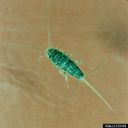Lepismatidae
Lepismatidae
Classification
- Phylum: Arthropoda
- Subphylum: Hexapoda
- Class: Insecta
- Order: Zygentoma
- Family: Lepismatidae
Pronunciation
How to pronounce Lepismatidae: //ˌlɛpɪsˈmætɪdiː//
These audio files are automatically generated. While they are not always 100% accurate, they are a good starting point.
Images






Summary
Lepismatidae is a family of primitive wingless insects, known for their elongated, flattened bodies and ability to thrive in warm, damp environments. This family includes the common silverfish and the firebrat, both of which are scavengers feeding on various organic materials.
Physical Characteristics
Lepismatids are elongated, flattened insects, with an average body size of 8-19 mm. They possess small, well-separated compound eyes and their abdomens are usually covered with tiny scales, terminating in three 'tails' of roughly equal length.
Identification Tips
Look for elongated, flattened body shape and three equally long tails. The presence of compound eyes is a distinguishing feature among other insect groups.
Habitat
Lepismatidae typically inhabit warm, damp environments. They can be found indoors, in places like bathrooms and kitchens, and they often avoid light. Outdoor habitats include areas under bark, leaf litter, caves, and ant nests.
Distribution
Lepismatidae are cosmopolitan, found worldwide, with a concentration in human dwellings and various outdoor environments.
Diet
These insects are scavengers and primarily feed on starchy foods, cereals, moist wheat flour, and glue found on book bindings and wallpaper. Outdoor species also consume lichens.
Life Cycle
Life cycle details specific to Lepismatidae are not provided, but like many insects, they undergo several molts as they develop from nymphs to adults.
Reproduction
Detailed reproductive behaviors specific to Lepismatidae are not provided, but generally, they mate and produce eggs, which develop into nymphs.
Predators
Specific predators of Lepismatidae are not documented, but they may be preyed upon by various spiders and other insectivorous animals.
Ecosystem Role
Lepismatidae play a role as decomposers and scavengers, contributing to the breakdown of organic material in their habitats.
Economic Impact
These insects can be considered pests in homes, especially when they damage paper products and stored food items.
Health Concerns
While Lepismatidae themselves are not known to pose significant health risks, their presence may indicate damp conditions that could lead to mold growth, which can affect health.
Collecting Methods
- Hand collection in habitat
- Sticky traps
Preservation Methods
- Ethanol preservation
- Drying specimens
Evolution
Lepismatidae is one of five families in the order Zygentoma and is considered primitive due to its wingless nature and ecological adaptations.
Similar Taxa
- Zygentoma
- Thysanura
Misconceptions
A common misconception is that silverfish are a sign of poor hygiene; while they may favor damp, warm areas associated with human activity, they do not thrive in unclean environments per se.
Tags
- silverfish
- firebrat
- Lepismatidae
- Zygentoma
- insects